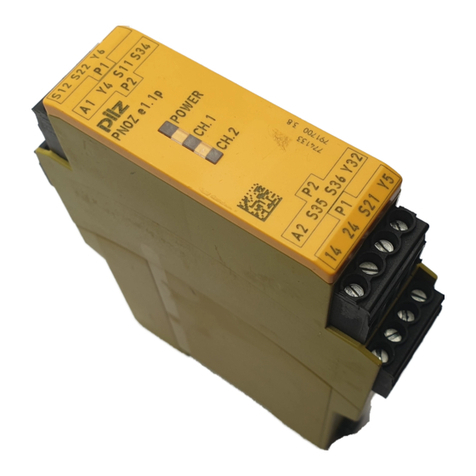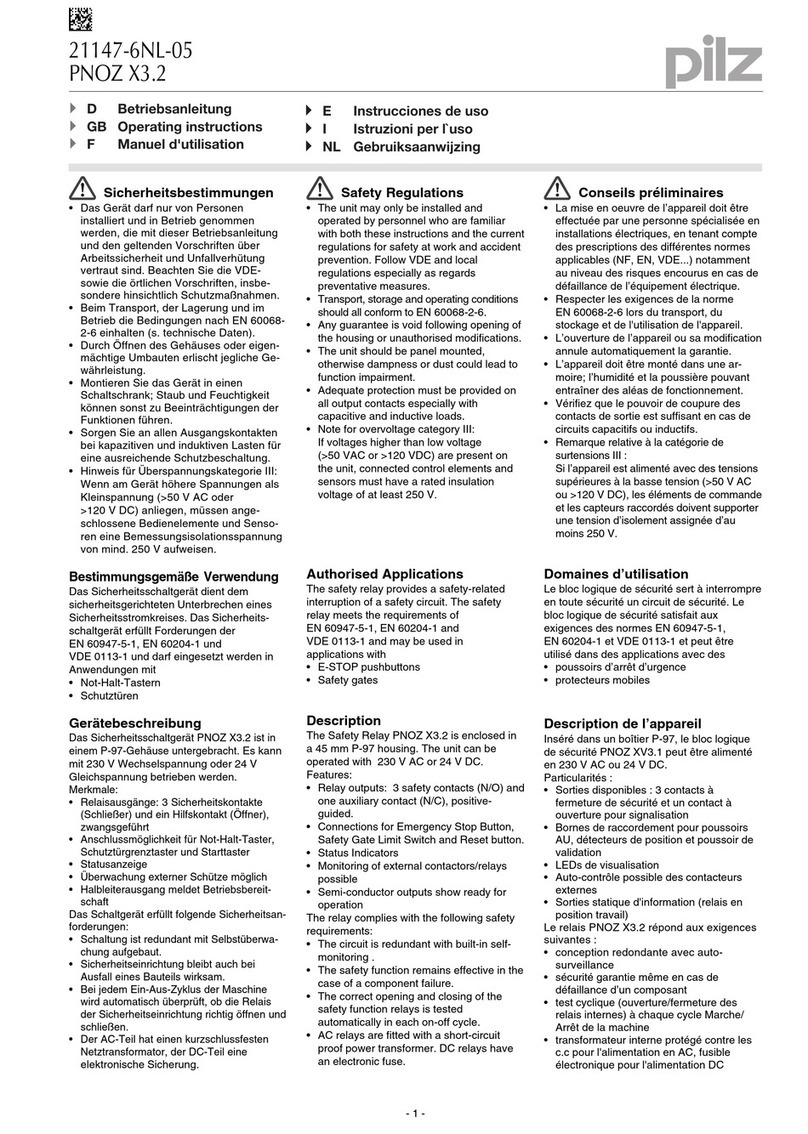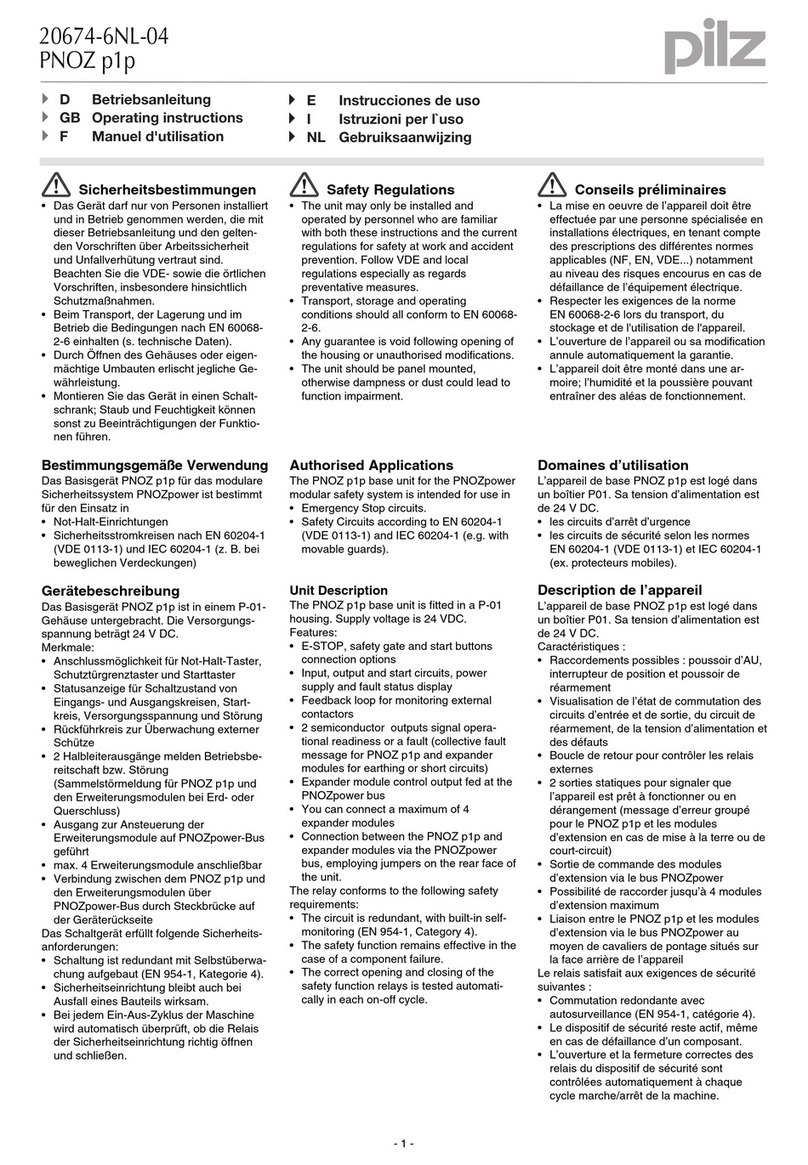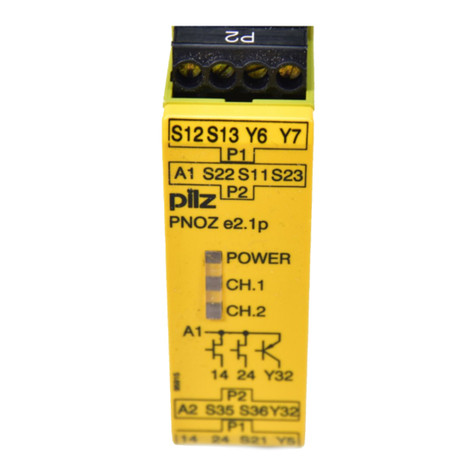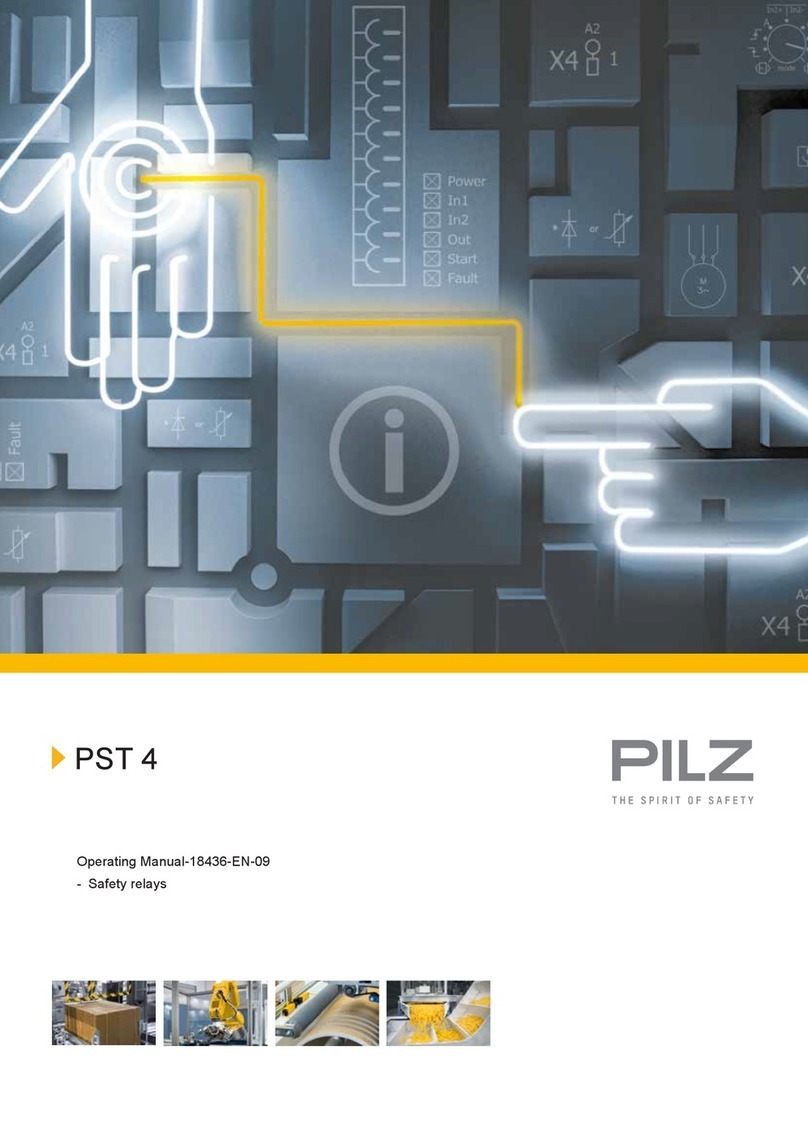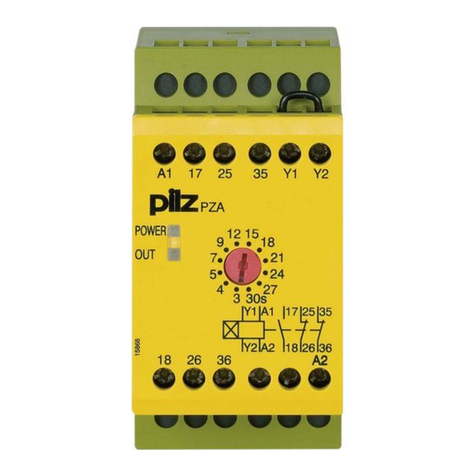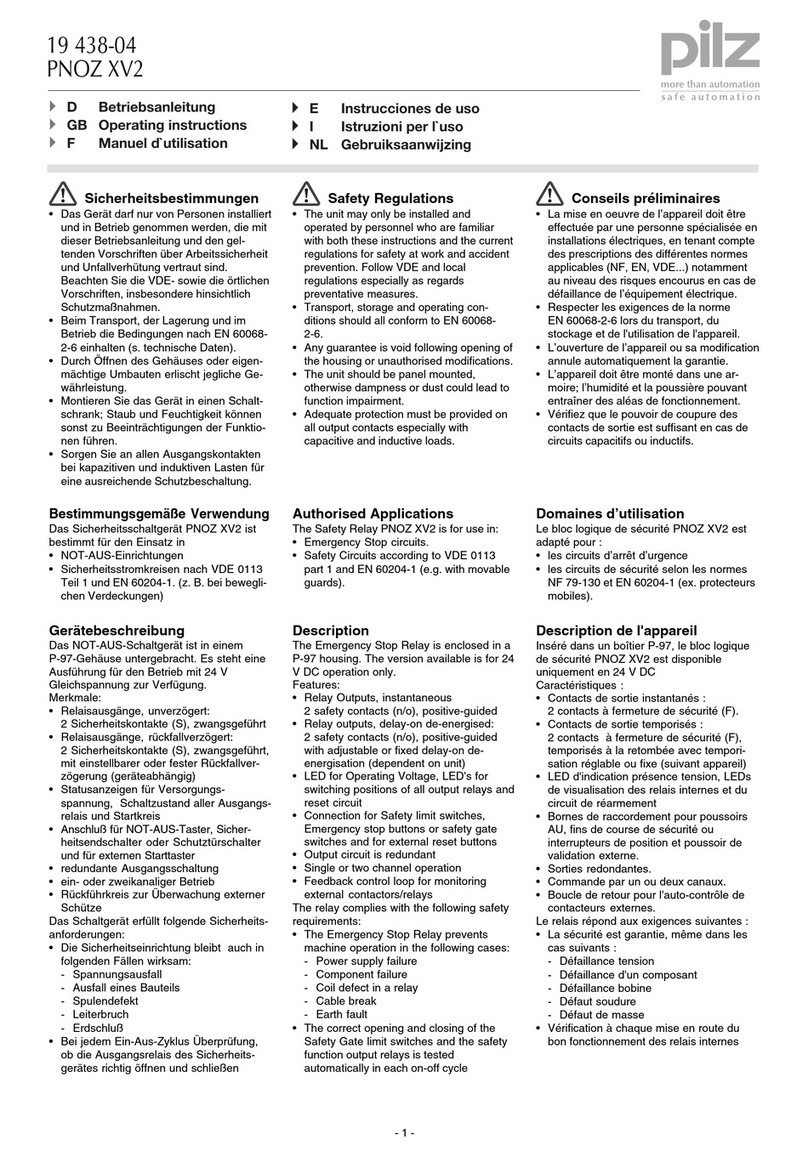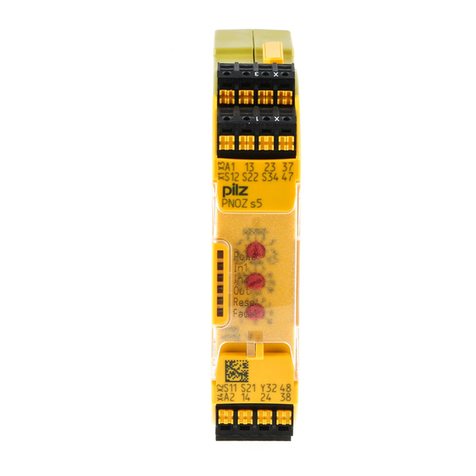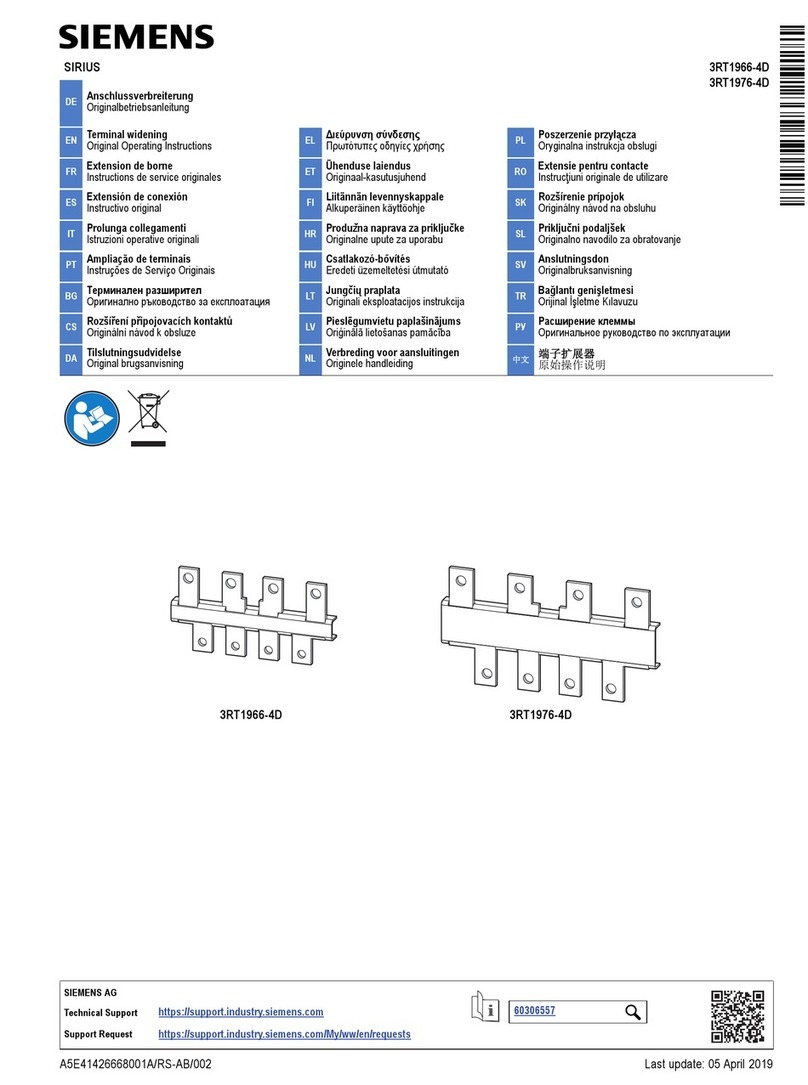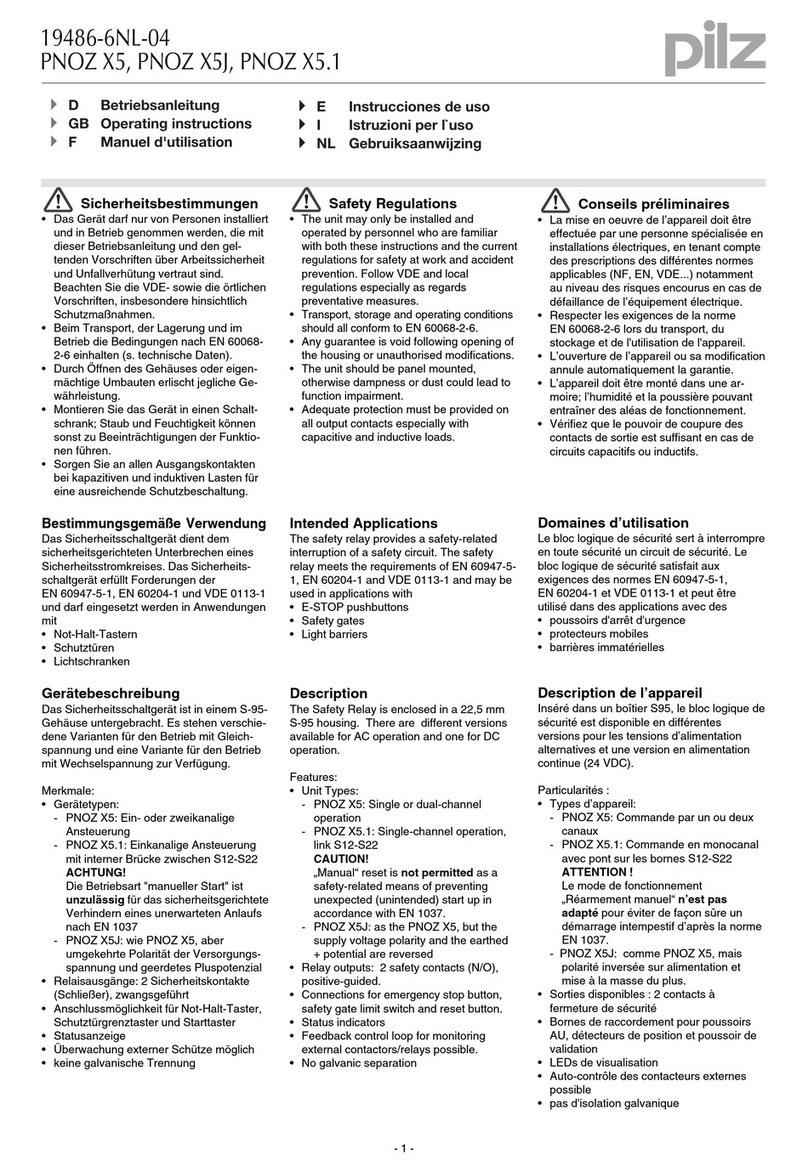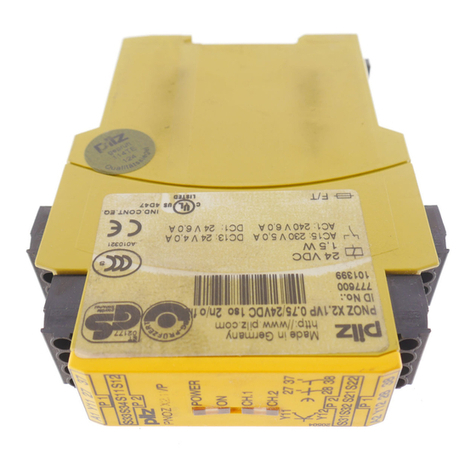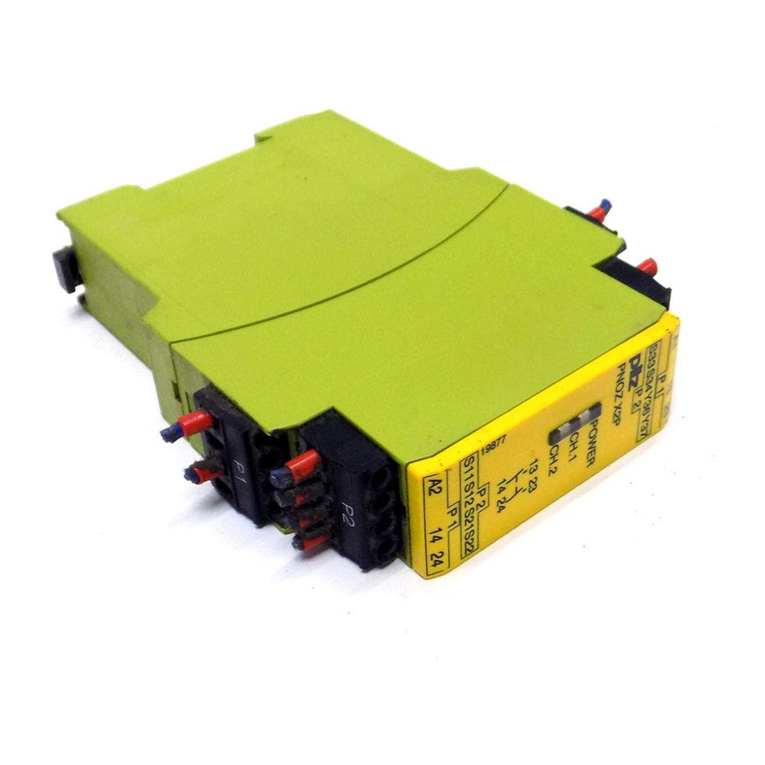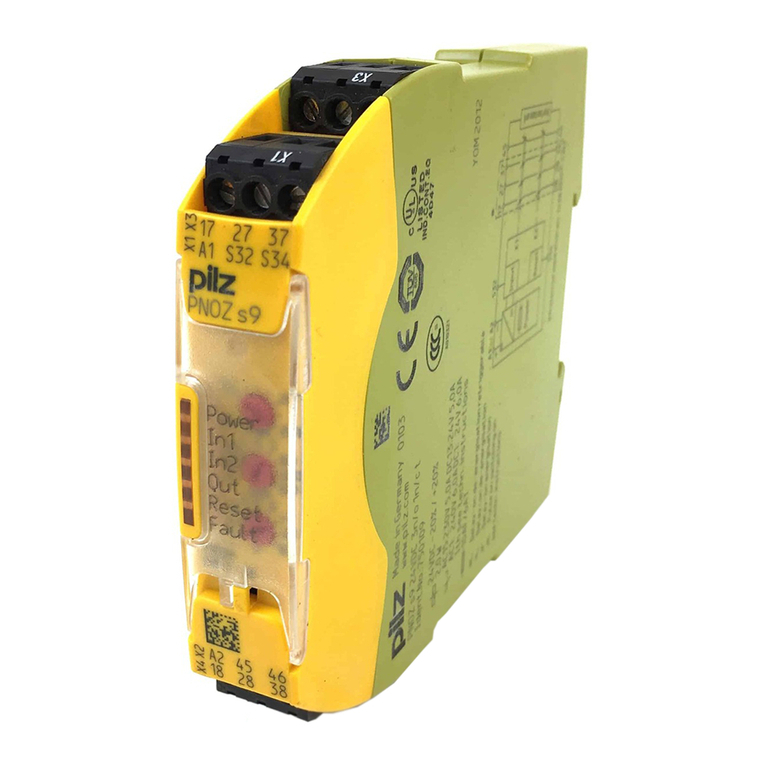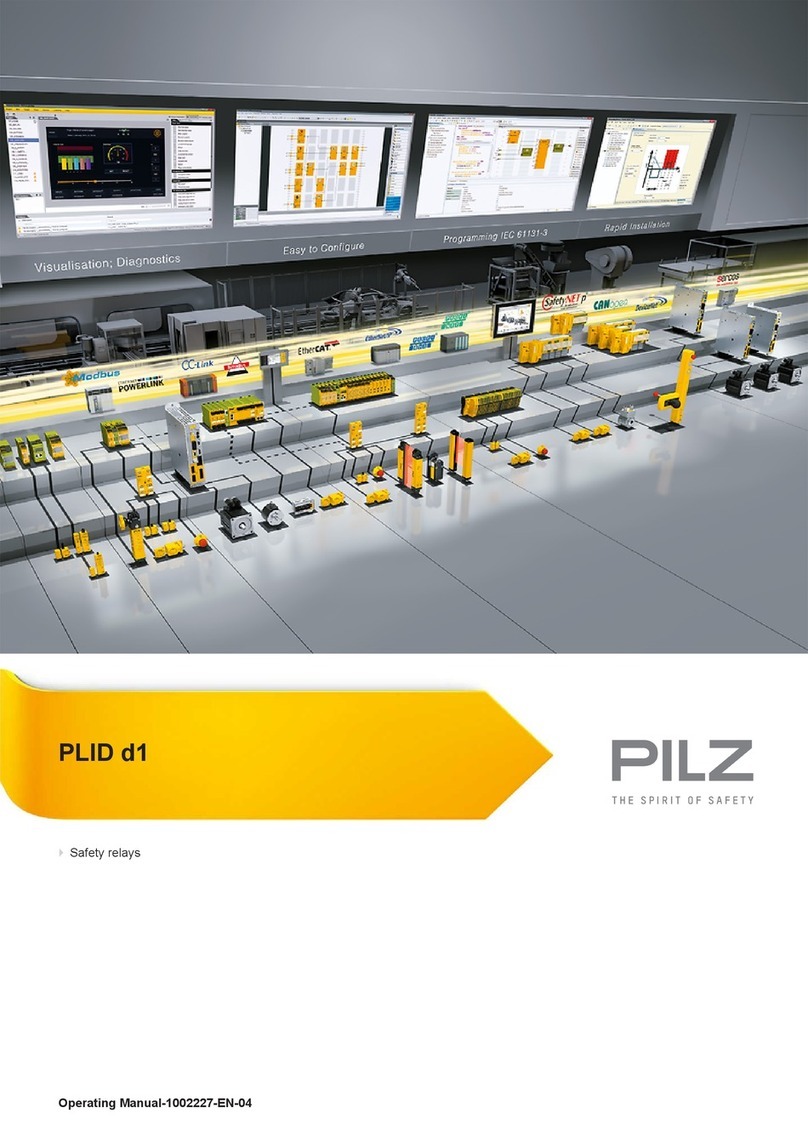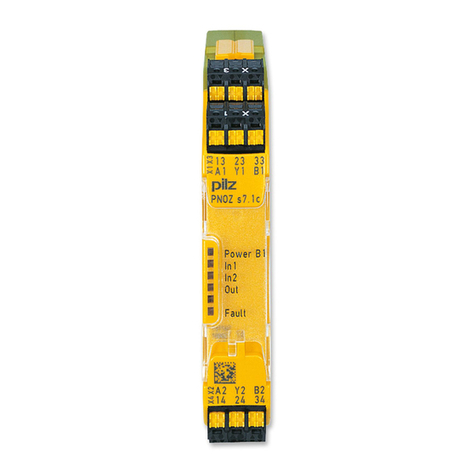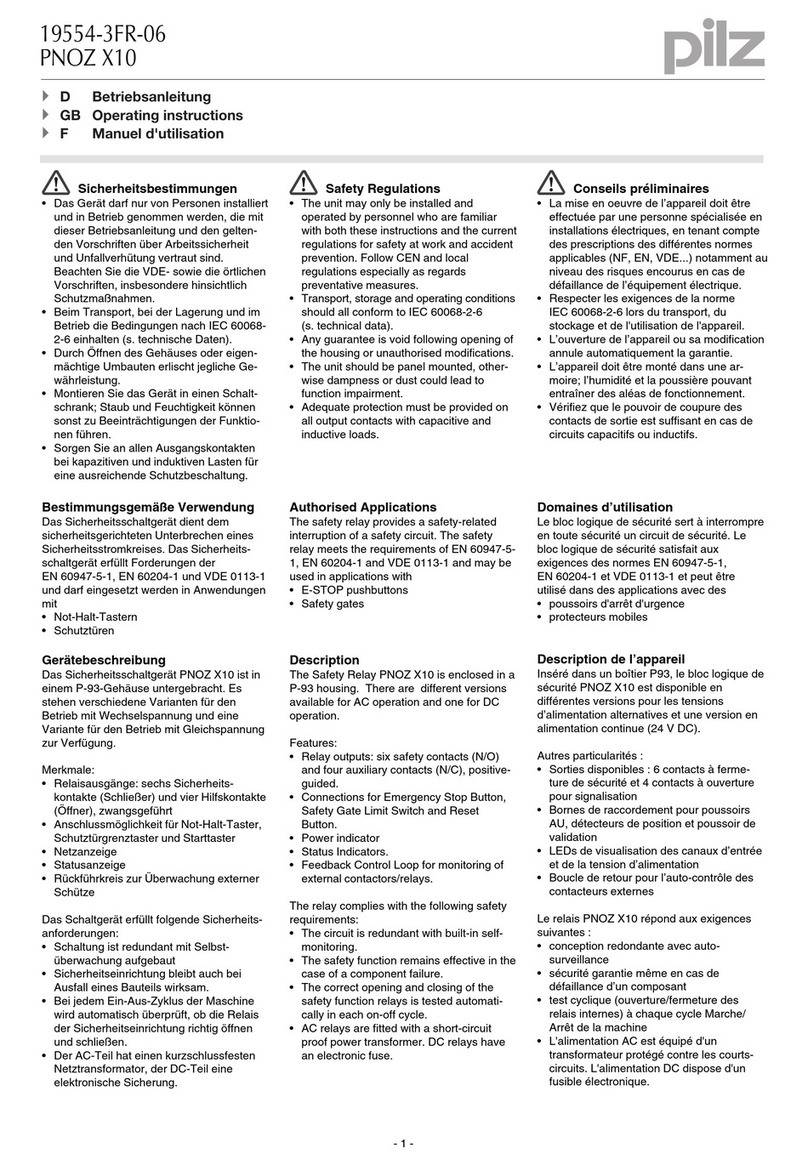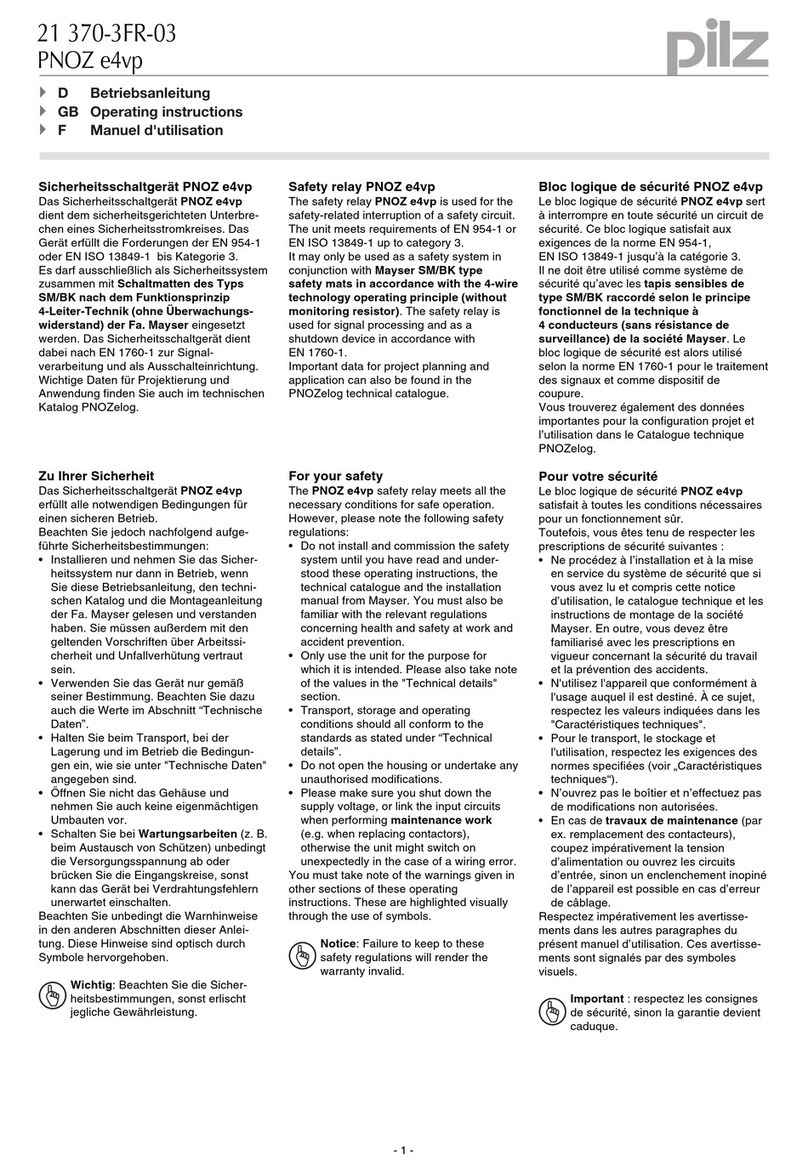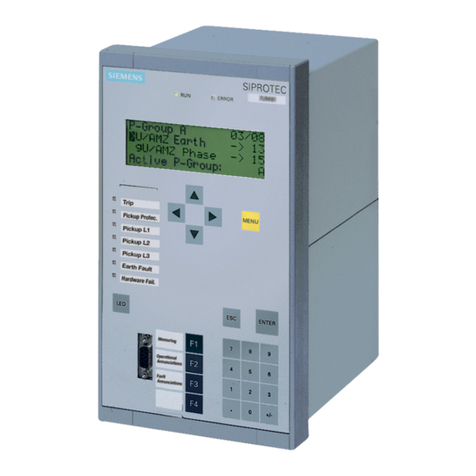
- 10 -
Características funcionales
El relé PNOZ XV2.1P sirve para una interrup-
ción por motivos de seguridad, de un circuito
de seguridad. A la puesta bajo tensión se
enciende el LED „Power“. El dispositivo se
activa si el circuito de rearme S13-S14 está
cerrado o un contacto de rearme en S33-S34
fue abierto y nuevamente cerrado. Se encien-
de el LED „start“.
• Circuito de entrada cerrado (por ej. parada
de emergencia no accionada):
Los relés K1, K2, K3 y K4 pasan a posición
activa y se automantienen. Los indicadores de
estado „CH.1“, „CH.2“ y „CH.1(t)“, „CH.2(t)“ se
encienden. Los contactos de seguridad 13-14/
23-24/37-38/47-48 están cerrados.
• Circuito de entrada abierto (por ej. parada
de emergencia accionada):
Los relés K1 y K2 pasan a la posición de repo-
so. El indicador de estado „CH.1“ y „CH.2“ se
apagan. Los contactos de seguridad 13-14 y
23-24 se abren de forma redundante. Después
de transcurrido el tiempo de retardo re-gulado,
los relés K3 y K4 vuelven a caer. Los contactos
de seguridad 37-38 y 47-48 se abren y los LED
„CH.1(t)“ y „CH.2(t)“ se apagan.
Antes de que el dispositivo se pueda rearmar
nuevamente, debe haber transcurrido el tiem-
po de retardo y todos los contactos de parada
de emergencia y de seguridad deben estar
cerrados nuevamente (per ej. circuito de
realimentación).
Interrumpir el tiempo de retardo:
Mediante el accionamiento de un pulsador de
reset (Y39-Y40) se interrumpe el tiempo de
retardo ajustado y los contactos de seguridad
37-38 y 47-48 se abren inmediatamente
Fig. 1: Diagrama de conexionado interno/Schema di collegamento interno/Intern schema
Descrizione del funzionamento
L’apparecchio elettrico PNOZ XV2.1P serve
per interrompere in modo sicuro un circuito
elettrico di sicurezza. Dopo l’applicazione
della tensione di alimentazione si accende il
LED “Power”. L’apparecchio è pronto per l’uso
dopo che è stato chiuso il circuito start S13-
S14, o dopo che un contatto di start su S33-
S34 è stato aperto e nuovamente chiuso. l LED
“start” è acceso.
• Con il circuito di entrata chiuso (per es.
pulsante di arresto di emergenza non
azionato), i relè K1, K2, K3 e K4 si attivano
automantenendosi. I LED di stato di
„CH.1“, „CH.2“ e „CH.1(t)“, „CH.2(t)“ sono
accesi. I contatti di sicurezza 13-14/23-24/
37-38/47-48 sono chiusi.
• Quando il circuito di entrata viene aperto
(per es. in caso di azionamento del
pulsante di arresto di emergenza), i relè
K1 e K2 tornano nella posizione di riposo.
La visualizzazione stato per „CH.1” e
„CH.2” si spegne. I contatti di sicurezza
13-14 e 23-24 vengono aperti in modo
ridondante. Al termine del ritardo regolato i
relè K3 e K4 si disattivano. I contatti di
sicurezza 37-38 e 47-48 si aprono ed i
LED „CH.1(t)“ e „CH.2(t)“ si spengono.
Prima do poter riavviare l’apparecchio si deve
attendere il tempo di ritardo e tutti i contatti di
arresto di emergenza e di sicurezza devono
essere nuovamente chiusi (per es. circuito di
rilettura).
Interrompere il tempo di ritardo:
Azionando un tasto reset (Y39-Y40) il tempo di
ritardo regolato viene interrotto ed i contatti di si-
curezza 37-38 e 47-48 si aprono immediatamente.
Modalità operative:
• Funzionamento monocanale: Cablaggio di
entrata secondo VDE 0113 e EN 60204,
senza ridondanza del circuito di entrata; le
dispersioni verso terra vengono rilevate nel
circuito del pulsante di arresto di emergenza.
• Funzionamento bicanale: Circuito di
entrata ridondante; vengono rilevate le
dispersioni verso terra nel circuito del
pulsante, nonché i cortocircuiti tra i contatti
del pulsante stesso.
• Start automatico: l’apparecchio è attivo
non appena il circuito di entrata è chiuso.
• Start manuale controllato: il dispositivo è
attivo solo quando, prima della chiusura
del circuito di ingresso, il circuito di start
viene aperto, e chiuso solo dopo la
chiusura del circuito di entrata e al termine
di un tempo di pausa (v. dati tecnici). In tal
modo si esclude un'attivazione automatica
e un'esclusione del pulsante di start.
• Moltiplicazione ed amplificazione dei contatti
mediante il collegamento di relè esterni.
Functiebeschrijving
Het relais PNOZ XV2.1P dient om een
veiligheidscircuit met zekerheid te
onderbreken. Zodra de bedrijfsspanning is
ingeschakeld, licht de LED „Power“ op. Het
relais is bedrijfsklaar indien het startcircuit
S13-S14 gesloten is of een startcontact op
S33-S34 geopend en weer gesloten werd.
De LED „start“ licht op.
• Ingangscircuit gesloten (b.v. noodstopknop
niet bediend):
de relais K1, K2, K3 en K4 worden
bekrachtigd en nemen zichzelf over. De
status-LED’s voor „CH.1“, „CH.2“ en
„CH.1(t)“, „CH.2(t)“ lichten op. De
veiligheidscontacten 13-14/23-24/37-38/
47-48 zijn gesloten.
• Ingangscircuit wordt geopend
(b.v. noodstopknop bediend):
de relais K1 en K2 vallen af. De LED’s
voor „CH.1“ en „CH.2“ gaan uit. De
veiligheidscontacten 13-14 en 23-24
worden redundant geopend. Na afloop van
de ingestelde vertragingstijd vallen de
relais K3 en K4 af. De veiligheidscontacten
37-38 en 47-48 gaan open en de LED’s
„CH.1(t)“ en „CH.2(t)“ gaan uit.
Voor het relais opnieuw gestart kan worden,
moet de vertragingstijd afgelopen en moeten
alle noodstop- en veiligheidscontacten weer
gesloten zijn (b.v. Terugkoppelcircuit).
Vertragingstijd onderbreken:
Door het indrukken van een resetknop (Y39-
Y40) wordt de ingestelde vertragingstijd
onderbroken en worden de veiligheids-
contacten 37-38 en 47-48 direct geopend.
Bedrijfsmodi:
• Eenkanalig bedrijf: ingangsschakeling
volgens VDE 0113 en EN 60204, geen
redundantie in het ingangscircuit. Aardslui-
tingen in het ingangscircuit worden
gedetecteerd.
• Tweekanalig bedrijf: redundant ingangs-
circuit, aardsluitingen in het ingangscircuit
en onderlinge sluitingen tussen de
knopcontacten worden gedetecteerd.
• Automatische start: apparaat is actief
zodra het ingangscircuit gesloten is.
• Handmatige start met bewaking: apparaat
is alleen actief, als vóór het sluiten van het
ingangscircuit het startcircuit geopend
wordt en na het sluiten van het
ingangscircuit en na afloop van de
wachttijd (zie technische gegevens) het
startcircuit gesloten wordt. Daardoor is
automatische activering door overbrugging
van de startknop uitgesloten.
• Contactvermeerdering en -versterking door
aansluiting van externe magneet-
schakelaars.
A1 A2 S13
S14 S12
S21
S34 47
48
S11
S22
S32
S31 13 37
14 38
K1
K2
23
24
CH1
CH2 Start
Unit
S33
Y39
Y40
K4
K3
_
_
~
_
Modos de funcionamiento:
• Modo monocanal: Conexión de la entrada
según VDE 0113 y EN 60204, no existe la
redundancia en el circuito de entrada. Los
defectos a tierra son detectados en el
circuito de paro de emergencia.
• Modo bicanal: Se reconoce el circuito de
entrada redundante. Se detectan los defec-
tos a tierra en el circuito del paro de emer-
gencia. Los cortocircuitos a través del paro
de emergencia también son detectados.
• Rearme automático: El dispositivo se activa tan
pronto como se cierra el circuito de entrada.
• Rearme manual con supervisión:
El
dispositivo se activa solamente si el circuito
de rearme se abre antes de cerrarse el
circuito de entrada y se cierra después de
cerrarse el circuito de entrada y de
transcurrir el tiempo de espera (ver datos
técnicos). De esta forma se excluye una
activación automática y el puenteado del
pulsador de rearme.
• Ampliación y reforzamiento de los contactos
mediante conexión de contactores externos.
